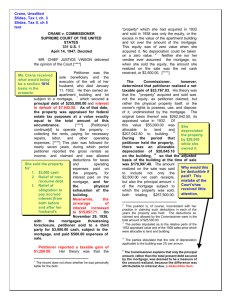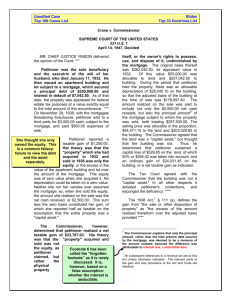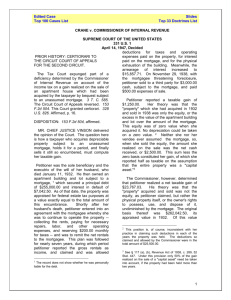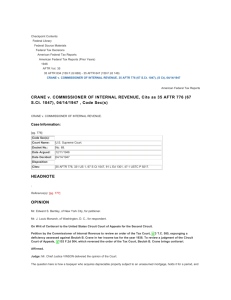Crane - Jeffrey Kahn
advertisement
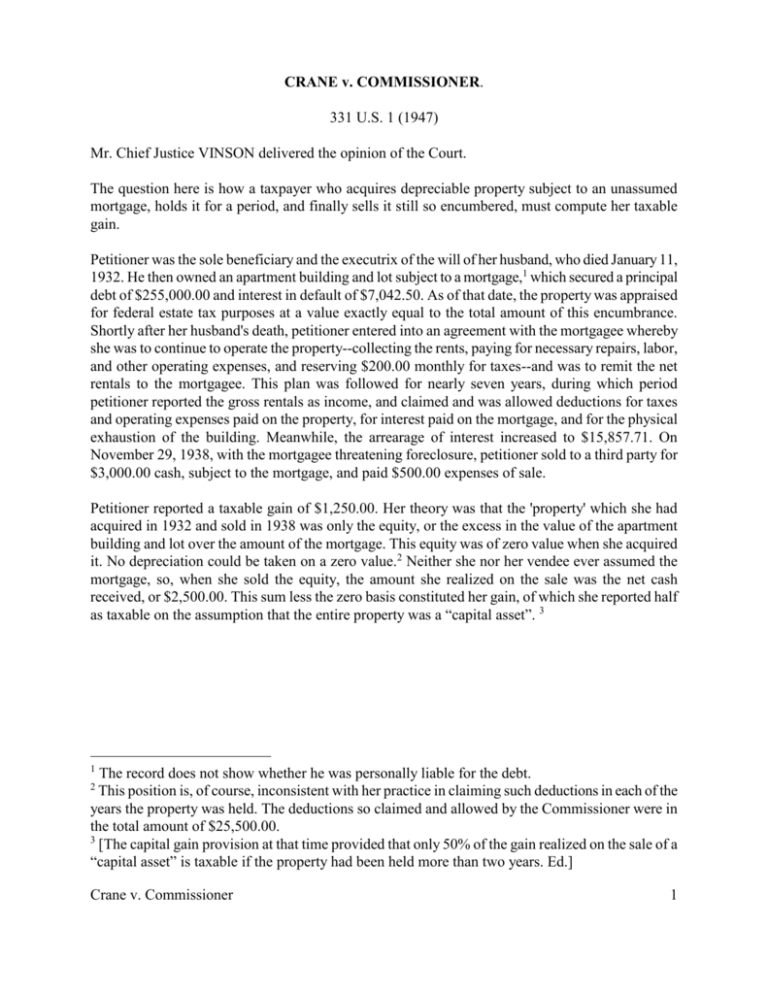
CRANE v. COMMISSIONER. 331 U.S. 1 (1947) Mr. Chief Justice VINSON delivered the opinion of the Court. The question here is how a taxpayer who acquires depreciable property subject to an unassumed mortgage, holds it for a period, and finally sells it still so encumbered, must compute her taxable gain. Petitioner was the sole beneficiary and the executrix of the will of her husband, who died January 11, 1932. He then owned an apartment building and lot subject to a mortgage,1 which secured a principal debt of $255,000.00 and interest in default of $7,042.50. As of that date, the property was appraised for federal estate tax purposes at a value exactly equal to the total amount of this encumbrance. Shortly after her husband's death, petitioner entered into an agreement with the mortgagee whereby she was to continue to operate the property--collecting the rents, paying for necessary repairs, labor, and other operating expenses, and reserving $200.00 monthly for taxes--and was to remit the net rentals to the mortgagee. This plan was followed for nearly seven years, during which period petitioner reported the gross rentals as income, and claimed and was allowed deductions for taxes and operating expenses paid on the property, for interest paid on the mortgage, and for the physical exhaustion of the building. Meanwhile, the arrearage of interest increased to $15,857.71. On November 29, 1938, with the mortgagee threatening foreclosure, petitioner sold to a third party for $3,000.00 cash, subject to the mortgage, and paid $500.00 expenses of sale. Petitioner reported a taxable gain of $1,250.00. Her theory was that the 'property' which she had acquired in 1932 and sold in 1938 was only the equity, or the excess in the value of the apartment building and lot over the amount of the mortgage. This equity was of zero value when she acquired it. No depreciation could be taken on a zero value.2 Neither she nor her vendee ever assumed the mortgage, so, when she sold the equity, the amount she realized on the sale was the net cash received, or $2,500.00. This sum less the zero basis constituted her gain, of which she reported half as taxable on the assumption that the entire property was a “capital asset”. 3 1 The record does not show whether he was personally liable for the debt. This position is, of course, inconsistent with her practice in claiming such deductions in each of the years the property was held. The deductions so claimed and allowed by the Commissioner were in the total amount of $25,500.00. 3 [The capital gain provision at that time provided that only 50% of the gain realized on the sale of a “capital asset” is taxable if the property had been held more than two years. Ed.] 2 Crane v. Commissioner 1 The Commissioner, however, determined that petitioner realized a net taxable gain of $23,767.03. His theory was that the “property” acquired and sold was not the equity, as petitioner claimed, but rather the physical property itself, or the owner's rights to possess, use, and dispose of it, undiminished by the mortgage. The original basis thereof was $262,042.50, its appraised value in 1932. Of this value $55,000.00 was allocable to land and $207,042.50 to building.4 During the period that petitioner held the property, there was an allowable depreciation of $28,045.10 on the building, so that the adjusted basis of the building at the time of sale was $178,997.40. The amount realized on the sale was said to include not only the $2,500.00 net cash receipts, but also the principal amount of the mortgage5 subject to which the property was sold, both totaling $257,500.00. The selling price was allocable in the proportion, $54,471.15 to the land and $203,028.85 to the building. The Commissioner agreed that the land was a “capital asset”, but thought that the building was not. Thus, he determined that petitioner sustained a capital loss of $528.85 on the land, of which 50% or $264.42 was taken into account, and an ordinary gain of $24.031.45 on the building, or a net taxable gain as indicated. The Tax Court agreed with the Commissioner that the building was not a “capital asset.” In all other respects it adopted petitioner's contentions, and expunged the deficiency. Petitioner did not appeal from the part of the ruling adverse to her, and these questions are no longer at issue. On the Commissioner's appeal, the Circuit Court of Appeals reversed, one judge dissenting. *** [The references in the opinion to sections of the 1938 Act are changed in this opinion to the corresponding sections of the Internal Revenue code of 1986. Ed.] [Section 1001(a) of the 1986 Code}defines the gain from “the sale or other disposition of property” as “the excess of the amount realized therefrom over the adjusted basis provided in” [section 1011] * * *. “It proceeds [§ 1001(b)] to define “the amount realized from the sale or other disposition of property” as “the sum of any money received plus the fair market value of the property (other than money) received..” Further, in [§ 1016(a)(2)], the “adjusted basis for determining the gain or loss from the sale or other disposition of property” is declared to be “the basis determined under subsection (a), adjusted * * * ((1)(B)) * * * for exhaustion, wear and tear, obsolescence, amortization * * * to the extent allowed (but not less than the amount allowable) * * *.” The basis under subsection (a) 'if the property was acquired by * * * devise * * * or by the decedent's estate from the decedent”, [§ 1014], is “the fair market value of such property at the time of such acquisition.” Logically, the first step under this scheme is to determine the unadjusted basis of the property, under [§ 1014], and the dispute in this case is as to the construction to be given the term “property”. If “property”, as used in that provision, means the same thing as “equity”, it would necessarily follow 4 The parties stipulated as to the relative parts of the 1932 appraised value and of the 1938 sales price which were allocable to land and building. 5 The Commissioner explains that only the principal amount, rather than the total present debt secured by the mortgage, was deemed to be a measure of the amount realized, because the difference was attributable to interest due, a deductible item. Crane v. Commissioner 2 that the basis of petitioner's property was zero, as she contends. If, on the contrary, it means the land and building themselves, or the owner's legal rights in them, undiminished by the mortgage, the basis was $262,042.50. We think that the reasons for favoring one of the latter constructions are of overwhelming weight. In the first place, the words of statutes-- including revenue acts--should be interpreted where possible in their ordinary, everyday senses. The only relevant definitions of “property” to be found in the principal standard dictionaries are the two favored by the Commissioner, i.e., either that “property” is the physical thing which is a subject of ownership, or that it is the aggregate of the owner's rights to control and dispose of that thing. “Equity” is not given as a synonym, nor do either of the foregoing definitions suggest that it could be correctly so used. Indeed, “equity” is defined as 'the value of a property * * * above the total of the liens. * * * The contradistinction could hardly be more pointed. Strong countervailing considerations would be required to support a contention that Congress, in using the word “property”, meant “equity”, or that we should impute to it the intent to convey that meaning. In the second place, the Commission's position has the approval of the administrative construction of [§ 1014]. With respect to the valuation of property under that section, [the regulations] promulgated under the 1938 Act, provided that “the value of property as of the date of the death of the decedent as appraised for the purpose of the federal estate tax * * * shall be deemed to be its fair market value. * * *' The land and building here involved were so appraised in 1932, and their appraised value--$262,042.50--was reported by petitioner as part of the gross estate. This was in accordance with the estate tax law and regulations, which had always required that the value of decedent's property, undiminished by liens, be so appraised and returned, and that mortgages be separately deducted in computing the net estate. As the quoted provision of the Regulations has been in effect since 1918, and as the relevant statutory provision has been repeatedly reenacted since then in substantially the same form, the former may itself now be considered to have the force of law. Moreover, in the many instances in other parts of the Act in which Congress has used the word “property”, or expressed the idea of “property” or “equity”, we find no instances of a misuse of either word or of a confusion of the ideas. In some parts of the Act other than the gain and loss sections, we find “property” where it is unmistakably used in its ordinary sense. On the other hand, where either Congress or the Treasury intended to convey the meaning of “equity,” it did so by the use of appropriate language. A further reason why the word “property” in [§ 1001(a)] should not be construed to mean “equity” is the bearing such construction would have on the allowance of deductions for depreciation and on the collateral adjustments of basis. Section [167(a)] permits deduction from gross income of “a reasonable allowance for the exhaustion, wear and tear of property * * *.” Section [167(c)] declares that the 'basis upon which *** exhaustion, wear and tear * * * are to be allowed' is the adjusted basis “provided in [§§ 1011 and 1012] for the purpose of determining the gain upon the sale” of the property, which is the [§ 1014] basis “adjusted [by § 1016(a)(2)] * * * for exhaustion, wear and tear * * * to the extent allowed (but not less than the amount allowable) * * *.” Crane v. Commissioner 3 Under these provisions, if the mortgagor's equity were the [§ 1014] basis, it would also be the original basis from which depreciation allowances are deducted. If it is, and if the amount of the annual allowances were to be computed on that value, as would then seem to be required, they will represent only a fraction of the cost of the corresponding physical exhaustion, and any recoupment by the mortgagor of the remainder of that cost can be effected only by the reduction of his taxable gain in the year of sale.6 If, however, the amount of the annual allowances were to be computed on the value of the property, and then deducted from an equity basis, we would in some instances have to accept deductions from a minus basis or deny deductions altogether. The Commissioner also argues that taking the mortgagor's equity as the [§ 1014] basis would require the basis to be changed with each payment on the mortgage, and that the attendant problem of repeatedly recomputing basis and annual allowances would be a tremendous accounting burden on both the Commissioner and the taxpayer. Moreover, the mortgagor would acquire control over the timing of his depreciation allowances. Thus it appears that the applicable provisions of the Act expressly preclude an equity basis, and the use of it is contrary to certain implicit principles of income tax depreciation, and entails very great administrative difficulties. It may be added that the Treasury has never furnished a guide through the maze of problems that arise in connection with depreciating an equity basis, but, on the contrary, has consistently permitted the amount of depreciation allowances to be computed on the full value of the property, and subtracted from it as a basis. Surely, Congress' long-continued acceptance of this situation gives it full legislative endorsement. We conclude that the proper basis under [§ 1014] is the value of the property, undiminished by mortgages thereon, and that the correct basis here was $262,042.50. The next step is to ascertain what adjustments are required under [§ 1016(a)(2)]. As the depreciation rate was stipulated, the only question at this point is whether the Commissioner was warranted in making any depreciation adjustments whatsoever. Section [1016(a)] provides that “proper adjustment in respect of the property shall in all cases be made * * * for exhaustion, wear and tear * * * to the extent allowed (but not less than the amount allowable * * *.” The Tax Court found on adequate evidence that the apartment house was property of a kind subject to physical exhaustion, that it was used in taxpayer's trade or business, and consequently that the taxpayer would have been entitled to a depreciation allowance under [§ 167], except that, in the opinion of that Court, the basis of the property was zero, and it was thought that depreciation could not be taken on a zero basis. As we have just decided that the correct basis of the property was not zero, but $262,042.50, we avoid this difficulty, and conclude that an adjustment 6 This is contrary to Treasury practice, and to Reg. 101, Art. 23(1)--5, which provides in part: “The capital sum to be recovered shall be charged off over the useful life of the property, either in equal annual installments or in accordance with any other recognized trade practice, such as an apportionment of the capital sum over units of production.” Crane v. Commissioner 4 should be made as the Commissioner determined. Petitioner urges to the contrary that she was not entitled to depreciation deductions, whatever the basis of the property, because the law allows them only to one who actually bears the capital loss, and here the loss was not hers but the mortgagee's. We do not see, however, that she has established her factual premise. There was no finding of the Tax Court to that effect, nor to the effect that the value of the property was ever less than the amount of the lien. Nor was there evidence in the record, or any indication that petitioner could produce evidence, that this was so. The facts that the value of the property was only equal to the lien in 1932 and that during the next six and one-half years the physical condition of the building deteriorated and the amount of the lien increased, are entirely inconclusive, particularly in the light of the buyer's willingness in 1938 to take subject to the increased lien and pay a substantial amount of cash to boot. Whatever may be the rule as to allowing depreciation to a mortgagor on property in his possession which is subject to an unassumed mortgage and clearly worth less than the lien, we are not faced with that problem and see no reason to decide it now. At last we come to the problem of determining the 'amount realized' on the 1938 sale. Section [1001(b)], it will be recalled, defines the “amount realized” from “the sale * * * of property” as “the sum of any money received plus the fair market value of the property (other than money) received,” and [§ 1001(a)] defines the gain on “the sale * * * of property” as the excess of the amount realized over the basis. Quite obviously, the word “property”, used here with reference to a sale, must mean “propert”' in the same ordinary sense intended by the use of the word with reference to acquisition and depreciation in [§ 1014], both for certain of the reasons stated heretofore in discussing its meaning in [§ 1014], and also because the functional relation of the two sections requires that the word mean the same in one section that it does in the other. If the “property” to be valued on the date of acquisition is the property free of liens, the “property” to be priced on a subsequent sale must be the same thing.*** Starting from this point, we could not accept petitioner's contention that the $2,500.00 net cash was all she realized on the sale except on the absurdity that she sold a quarter-of-a-million dollar property for roughly one per cent of its value, and took a 99 per cent loss. Actually, petitioner does not urge this. She argues, conversely, that because only $2,500.00 was realized on the sale, the “property” sold must have been the equity only, and that consequently we are forced to accept her contention as to the meaning of ”property” in [§ 1014]. We adhere, however, to what we have already said on the meaning of 'property', and we find that the absurdity is avoided by our conclusion that the amount of the mortgage is properly included in the “amount realized” on the sale. Petitioner concedes that if she had been personally liable on the mortgage and the purchaser had either paid or assumed it, the amount so paid or assumed would be considered a part of the “amount realized” within the meaning of [§ 1001(b)]. The cases so deciding have already repudiated the notion that there must be an actual receipt by the seller himself of “money” or “other property”, in their narrowest senses.*** ***[W]e think that a mortgagor, not personally liable on the debt, who sells the property subject to the mortgage and for additional consideration, realizes a benefit in the amount of the mortgage as Crane v. Commissioner 5 well as the boot.7 If a purchaser pays boot, it is immaterial as to our problem whether the mortgagor is also to receive money from the purchaser to discharge the mortgage prior to sale, or whether he is merely to transfer subject to the mortgage--it may make a difference to the purchaser and to the mortgagee, but not to the mortgagor. Or put in another way, we are no more concerned with whether the mortgagor is, strictly speaking, a debtor on the mortgage, than we are with whether the benefit to him is, strictly speaking, a receipt of money or property. We are rather concerned with the reality that an owner of property, mortgaged at a figure less than that at which the property will sell, must and will treat the conditions of the mortgage exactly as if they were his personal obligations.If he transfers subject to the mortgage, the benefit to him is as real and substantial as if the mortgage were discharged, or as if a personal debt in an equal amount had been assumed by another. Therefore we conclude that the Commissioner was right in determining that petitioner realized $257,500.00 on the sale of this property. Petitioner contends that the result we have reached taxes her on what is not income within the meaning of the Sixteenth Amendment. If this is because only the direct receipt of cash is thought to be income in the constitutional sense, her contention is wholly without merit. If it is because the entire transaction is thought to have been “by all dictates of common-sense * * * a ruinous disaster”, as it was termed in her brief, we disagree with her premise. She was entitled to depreciation deductions for a period of nearly seven years, and she actually took them in almost the allowable amount. The crux of this case, really, is whether the law permits her to exclude allowable deductions from consideration in computing gain.8 We have already showed that, if it does, the taxpayer can enjoy a double deduction, in effect, on the same loss of assets. The Sixteenth Amendment does not require that result any more than does the Act itself. Affirmed. [ The dissent of Mr. Justice Jackson, in which Justices Frankfurter and Douglas joined, is omitted.] 7 Obviously, if the value of the property is less than the amount of the mortgage, a mortgagor who is not personally liable cannot realize a benefit equal to the mortgage. Consequently, a different problem might be encountered where a mortgagor abandoned the property or transferred it subject to the mortgage without receiving boot. That is not this case. [The number of this footnote in the Crane case is 37, and it is often referred to as “footnote 37.” Ed.] 8 In the course of the argument some reference was made, as by analogy, to a situation in which a taxpayer acquired by devise property subject to a mortgage in an amount greater than the then value of the property, and later transferred it to a third person, still subject to the mortgage, and for a cash boot. Whether or not the difference between the value of the property on acquisition and the amount of the mortgage would in that situation constitute either statutory or constitutional income is a question which is different from the one before us, and which we need not presently answer. Crane v. Commissioner 6

